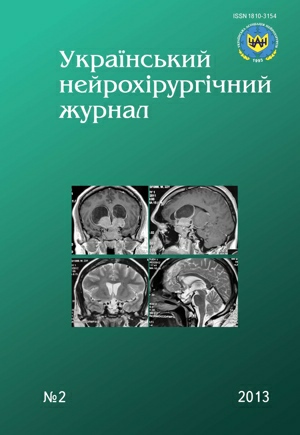Features of antibacterial therapy of nosocomial pneumonia in injures persons in the early period of traumatic brain injury
DOI:
https://doi.org/10.25305/unj.51868Keywords:
early period of TBI, hospital-acquired pneumonia, antibacterial therapy, risk factorsAbstract
Introduction. Hospital-acquired pneumonia (HAP) significantly complicates post-operative and posttraumatic period in patients in early period of traumatic brain injury (TBI). The purpose of the study was to study features of HAP course and antibacterial therapy (ABT) in patients with TBI been treated in neurosurgical (intensive care) unit of Kyiv City Emergency Hospital.
Materials and methods. A prospective clinical and microbiological study of infectious and inflammatory processes (HAP) in injured persons in the early period of TBI was provide on the base of neurosurgical (intensive care) unit of Kyiv City Emergency Hospital.
Results. HAP was diagnosed in 76 patients with isolated severe and moderate-severe TBI in the early period. Respiratory pathogens structure was identified, features of HAP course and impact of risk factors were studied, effectiveness of empirical etiotropic ABT was estimated in patients in the early period of TBI.
Conclusions. High efficiency of etiotropic application of antibiotics in comparison with empirical ABT was established. The risk factors complicating TBI clinical course were defined.
References
1. Pedachenko EG, Morozov AM. Suchasni standarty i orhanizatsiya likuvalno-diahnostychnoho protsesu pry cherepno-mozkoviy travmi [Modern standards and the organization of medical-diagnostic process in traumatic brain injury]. Visnyk sotsialnoi hihiyeny ta orhanizatsiyi okhorony zdorovya Ukrayiny. 1999;(1):115-120. Ukrainian.
2. Pedachenko EG, Shlapak IP, Huk AP, Pylypenko MM. Cherepno-mozkova travma: suchasni pryntsypy nevidkladnoyi dopomohy: navch. metod. posibnyk [Traumatic brain injury: The modern principles of first aid. Guideline. Kiev: Varta; 2007. 311 p. Ukrainian.
3. Puras YuV, Talypov AE, Krylov VV. [Risk factors of adverse outcome in the surgical treatment of acute craniocerebral trauma]. Zhurnal im NV Sklifosovskogo "Neotlozhnaya Meditsinskaya Pomoshch". 2012;(2):26–33. Russian. [eLIBRARY.ru]
4. Krylov VV, editor. Lektsii po cherepno-mozgovoy travme [Lectures on traumatic brain injury]. Moscow: Meditsina; 2010. 320 p.
5. Reilly PL, Bullock MR, editors. Head injury. Pathophysiology and management. 2nd ed. London: Hodder Arnold; 2005. 501 p.
6. Jallo J, Loftus CM, editors. Neurotrauma and critical care of the brain. New York; Stuttgart: Thieme; 2009. 496 р.
7. [Clinical guidelines for the management of adult community acquired and nosocomial (hospital) pneumonia] [Internet]. Kiev (Ukraine): Ministry of Health of Ukraine; 2007 March 19. Ukrainian. Available from URL
8. Croghan JE, Burke EM, Caplan S, Denman S. Pilot study of 12-month outcomes of nursing home patients with aspiration on videofluoroscopy. Dysphagia. 1994 Summer;9(3):141-6. [PubMed] [CrossRef]
9. Teramoto S, Kawashima M, Komiya K, Shoji S. Health-care-associated pneumonia is primarily due to aspiration pneumonia. Chest. 2009 Dec;136(6):1702-3; author reply 1703. [PubMed] [CrossRef]
10. Finegold SM. Aspiration pneumonia. Rev Infect Dis. 1991 Jul-Aug;13 Suppl 9:S737-42. Review. [PubMed] [CrossRef]
11. Robert R, Grollier G, Doré P, Hira M, Ferrand E, Fauchère JL. Nosocomial pneumonia with isolation of anaerobic bacteria in ICU patients: therapeutic considerations and outcome. J Crit Care. 1999 Sep;14(3):114-9. [PubMed] [CrossRef]
12. Woodhead M, Blasi F, Ewig S, Garau J, Huchon G, Ieven M, Ortqvist A, Schaberg T, Torres A, van der Heijden G, Read R, Verheij TJ; Joint Taskforce of the European Respiratory Society and European Society for Clinical Microbiology and Infectious Diseases. Guidelines for the management of adult lower respiratory tract infections--full version. Clin Microbiol Infect. 2011 Nov;17 Suppl 6:E1-59. [PubMed] [CrossRef]
13. Germaud P, Poirier J, Jacqueme P, Guerin JC, Benard Y, Boutin C, Brambilla C, Escamilla R, Zuck P. [Monotherapy using amoxicillin/clavulanic acid as treatment of first choice in community-acquired lung abscess. Apropos of 57 cases]. Rev Pneumol Clin. 1993;49(3):137-41. French. [PubMed]
14. [Neurosurgery & Pediatric Neurosurgery: Clinical Guidelines]. Ukrainian Neurosurgical Journal. 2008;(3):6-225. Ukrainian.
15. Cook D. Ventilator associated pneumonia: perspectives on the burden of illness. Intensive Care Med. 2000;26 Suppl 1:S31-7. Review. [PubMed] [CrossRef]
Downloads
Published
How to Cite
Issue
Section
License
Copyright (c) 2013 Vitaliy Tsymbalyuk, Pavlo Makovetsky, Sergiy Komarnytsky

This work is licensed under a Creative Commons Attribution 4.0 International License.
Ukrainian Neurosurgical Journal abides by the CREATIVE COMMONS copyright rights and permissions for open access journals.
Authors, who are published in this Journal, agree to the following conditions:
1. The authors reserve the right to authorship of the work and pass the first publication right of this work to the Journal under the terms of Creative Commons Attribution License, which allows others to freely distribute the published research with the obligatory reference to the authors of the original work and the first publication of the work in this Journal.
2. The authors have the right to conclude separate supplement agreements that relate to non-exclusive work distribution in the form of which it has been published by the Journal (for example, to upload the work to the online storage of the Journal or publish it as part of a monograph), provided that the reference to the first publication of the work in this Journal is included.









